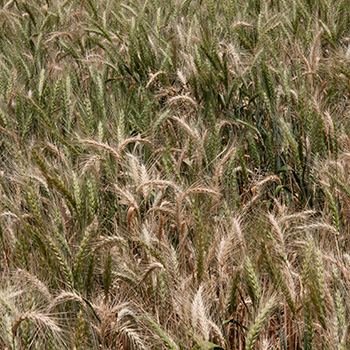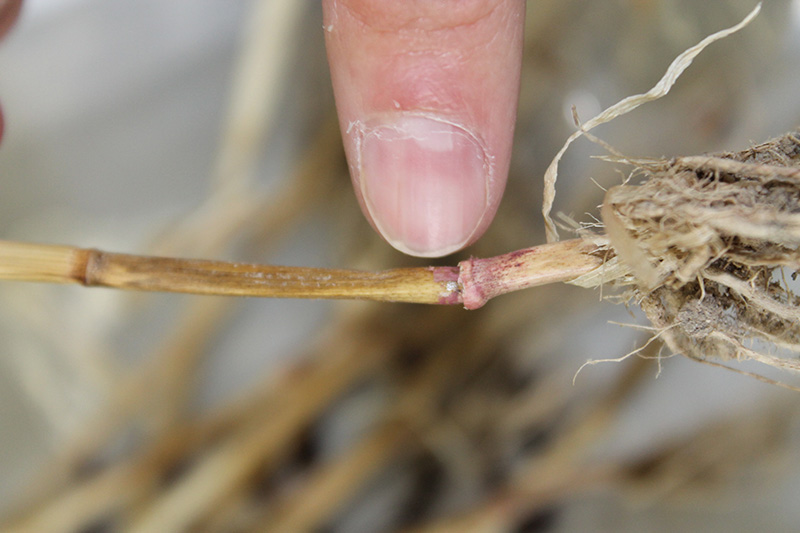Paddock Practices: Alert to manage Fusarium crown rot across Riverine Plains
Paddock Practices: Alert to manage Fusarium crown rot across Riverine Plains
Date: 04 Apr 2024

Key points
- PreDicta B DNA soil tests across the Riverine Plains region of north-east Victoria and south-west NSW have shown medium to high levels of Fusarium crown rot leading into sowing in 2024.
- The presence of Fusarium crown rot poses a risk of 5-60 per cent yield loss in cereals, especially in a dry spring.
- Paddocks being sown to a cereal this year with a history of tight cereal rotations and/or grass weeds may be at risk of Fusarium crown rot.
- If you have a high-risk paddock, contact your agronomist for a Predicta B soil test, or email sabita@riverineplains.org.au to arrange and test a stubble sample.
- If you have found Fusarium crown rot, consult your agronomist who can discuss management options to curb yield loss, such as choosing a less susceptible cereal type/variety and inter-row sowing.
Medium to high risk of Fusarium crown rot in 2024
Through Predicta B soil testing across north-east Victoria and south-west NSW, farming systems group Riverine Plains has identified there is a medium to high risk of Fusarium crown rot across the region.
Riverine Plains has used Predicta B to test for Fusarium crown rot in 14 paddocks intended for cereals. Seventy per cent of these paddocks had medium to high levels of Fusarium crown rot inoculum.
Test high-risk paddocks now
Due to the elevated risk of Fusarium crown rot, both Riverine Plains and the Grains Research and Development Corporation (GRDC) are encouraging grain growers across the region to test paddocks for disease risk now.
Testing for Fusarium crown rot can be done via a soil sample using Predicta B testing or a stubble sample using laboratory culturing.
Riverine Plains reports that growers who utilise soil testing services can effectively assess the potential for yield loss this year and make practical changes to their paddock plans, to reduce future risk. Some strategies growers are implementing include switching from wheat to barley, applying zinc and sowing the paddock earlier in the sowing window.
Predicta B soil testing
Developed by the South Australian Research and Development Institute (SARDI), Predicta B is a DNA-based soil testing service for broadacre farming that can identify a range of different pathogens.
Growers across Australia – including in both Victoria and NSW – can access Predicta B soil testing by connecting with local agronomists who are accredited by SARDI to offer this service. Speak to your local agronomist to confirm their accreditation.
The accredited agronomists will organise sampling, interpret the results and advise on management options should Fusarium crown rot be present.
The cost of Predicta B testing is determined by the agronomist delivering the service.

Stubble sample testing
A free cereal stubble testing service is provided by the NSW Department of Primary Industries (NSW DPI) via a co-investment with GRDC. This service employs laboratory plating techniques to isolate the Fusarium fungus responsible for diseases in retained cereal stubble. By assessing inoculum levels both in the crown underground and in the cereal stubble above ground, the potential risk for subsequent cereal crops can be identified and guide management strategies.
Growers with retained cereal stubble can collect samples following a simple protocol and send them to NSW DPI for testing. Contact Sabita Duwal, Riverine Plains, who can send sample bags with instructions to growers.
Manage risk for Fusarium crown rot
Growers who identify Fusarium crown rot in their paddock/s should consult with an agronomist to discuss management options to curb yield loss, such as choosing a less susceptible cereal type/variety and inter-row sowing.
For more information contact your agronomist or see Reducing the risk of cereal yield losses from Fusarium crown rot (riverineplains.org.au). Key points from this blog to reduce the risk of cereal yield losses from Fusarium crown rot that growers can action include:
- Use paddock rotations that include at least two consecutive years of non-host crops, such as oilseeds, legumes or fallow. For paddocks with high levels (>50 per cent infection or high risk PreDicta B), sowing a non-host crop for 2-3 years may be warranted.
- Use effective weed management programs to reduce grass weed hosts in-crop and in fallow situations. However, remember the larger the grass weed the longer that residue serves as a potential inoculum source.
- Use practices that accelerate stubble decomposition (as the causal pathogen is stubble-borne) to decrease the risk. However, these same stubble management practices can also increase the spread of Fusarium crown rot inoculum across a paddock in the short term.
- Use inter-row sowing if cereals are to be planted into an at-risk paddock to increase the distance between the new and old plants, as most inoculum is in the stem bases of the previous cereal crop.
- Consider sowing a variety earlier within its ideal sowing window. This will bring the grain filling period forward slightly and may reduce water and heat stress, however this needs to be weighed against the risk of frost damage.
- Ensure nutrition is appropriate for the season. Excessive nitrogen will produce bulky crops that hasten moisture stress and make the expression of Fusarium crown rot more severe. Whitehead expression can also be made more severe by zinc deficiency.
- Select a cereal type and variety that has more tolerance to Fusarium crown rot and that is best suited to your region.
About Fusarium crown rot
Fusarium crown rot is usually caused by the fungus Fusarium pseudograminearum but also F.culmorum and F. graminearum in some areas. These fungi can survive three or more years inside cereal stubble.
Fusarium crown rot occurs across the southern and northern grain growing regions and can reduce yields in cereals by 5-60 per cent, especially in a dry spring. It can also reduce grain quality through increased screening levels.
The main risk factors include: paddocks being sown to a cereal that have a history of tight cereal rotations and/or grass weeds; paddocks being cultivated close to sowing; paddocks with a sub-soil constraint (e.g. compaction, another root disease issue such as root lesion nematodes, sodicity or acidity), which restricts root growth; and soil types within paddocks that are more prone to stress during grain filling (i.e. ‘just do not hold on as well’) or where trees compete for moisture (e.g. fence lines).
This Paddock Practices was produced using data and insights from Riverine Plains and the NSW Department of Primary Industries.
Useful resources
SARDI web page: Predicta B (broadacre) testing services to help grain growers identify which pathogens pose a risk to their crops before sowing.
Riverine Plains blog posts: Reducing the risk of cereal yield losses from Fusarium crown rot (Jan 2024)
Riverine Plains podcast: Interview with Dr Stephen Simpfendorfer, NSW DPI on Fusarium Crown Rot in the Riverine Plain (Buzzsprout or Spotify) (Apr 2024)
GroundCover
GRDC Podcast
GRDC Update Papers
- Strategies for managing fusarium crown rot: new data from northern NSW and southern Qld in 2023 (Mar 2024)
- A foe in the fallow: what happens with Fusarium crown rot between seasons? (Mar 2024
- Increased wheat plant population: the interaction with variety, Fusarium crown rot and nitrogen (Feb 2024)
- Strategies for managing fusarium crown rot: new data from central NSW in 2023
- Fusarium crown rot in central and northern cropping systems: it’s all a numbers game (Feb 2024)
- Implications of sowing Fusarium infected wheat seed in 2023 (Feb 2024)
GRDC Videos
Contacts
Kate Coffey – contact for sample bags for Riverine Plains region
Senior Project Officer, Riverine Plains
kate@riverineplains.org.au
0427 141 221
Nigel Percy – contact for a list of SARDI-accredited agronomists
SARDI
nigel.percy@sa.gov.au
08 8429 2236
Steven Simpfendorfer – contact for research questions about Fusarium
Senior Research Scientist NSW Department of Primary Industries
steven.simpfendorfer@dpi.nsw.gov.au
0439 581 672
GRDC Project Code: DPI2207-004RTX, RPI2309-002SAX,
